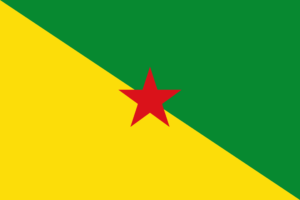The indigenous people of French Guiana were Native Americans. The French came to the area in the 17th century. A tropical disease made it difficult for them to survive. The Portuguese occupied the area for a short time (1809-1813), but soon the French regained control through the Treaty of Paris.
France used the infamous Devil’s Island, an island off the coast of French Guiana, as a penal colony for criminals. The French sent nearly 56,000 prisoners to the island, but few survived. In 1964, construction of a space station began in French Guiana. The Guiana Space Center is now an important part of the European space industry.
| Capital | Cayenne |
| Population | 313,313 (Source: 2023 worldometer) |
| Major Cities | Cayenne (capital), Matoury, Saint-Laurent-du-Maroni, Kourou. |
| Borders | Brazil to the south and east, Suriname to the west, and the Atlantic Ocean to the northeast |
| Gross Domestic Product (GDP) | $15,357,537,068 (2022 worldometer) |
| Currency | euro (EUR) |

French Guiana Major Industries: construction, shrimp processing, forestry products, rum, gold mining
French Guiana Agricultural Products: corn, rice, manioc (tapioca), sugar, cocoa, vegetables, bananas; cattle, pigs, poultry
French Guiana Natural Resources: bauxite, timber, gold (widely scattered), petroleum, kaolin, fish, niobium, tantalum, clay
French Guiana Major Exports: shrimp, timber, gold, rum, rosewood essence, clothing
French Guiana Major Imports: food (grains, processed meat), machinery and transport equipment, fuels and chemicals
Total Size of French Guiana: 643,801 sq km (source: 2022 The world factbook)
Geographical Low Point of French Guiana: Atlantic Ocean 0 m
Geographical High Point of French Guiana: Bellevue de l’Inini 851 m
Climate of French Guiana: Tropical; hot, humid; little seasonal temperature variation
General Terrain of French Guiana: low-lying coastal plains rising to hills and small mountains
World Region or Continent of French Guiana: South America
Geographical Coordinates: 4 00 N, 53 00 W
French Guiana Government Type: NA
French Guiana Nationality: French Guianese (singular and plural)
French Guiana National Holiday: Bastille Day, 14 July (1789)
French Guiana Independence: none (overseas department of France)
French Guiana National Symbol:
French Guiana National Anthem or Song:
French Guiana Languages Spoken: French
French Guiana Religions: Roman Catholic
The Spaniards explored the Guiana coast in 1500 and settled the Cayenne region in 1503.
In 1624 French merchants from Rouen established a trading center in the coastal village of Synnamary, and in 1643 Cayenne was founded by Rouen or other merchants from Paris.
The area was given to France by the Treaty of Breda in 1667, and the Dutch who held Cayenne in 1664 were exiled in 1676.
From 1877 onwards, the inhabitants of the area were declared French citizens and served in the French parliament.
Anne-Marie Javouhey continued the French Roman Catholic humanist tradition and, together with Father Francis Liebermann, founded one of the first educational institutions for freed black slaves and women.
In 1946 French Guiana became part of France and in 1974 was granted status as a region of South America.
The 1968 construction of a missile launch site and a new European Space Agency city in Kourou contributed to the adoption of the Plan Vert (Green Plan) in the late 1970s to promote increased agricultural and forestry production. Post-war economic stagnation.
The economic boom was unsustainable and unemployment remained high, leaving many French Guianas unhappy with the French authorities.
French Guiana, on the other hand, is developing a market economy modeled after mainland France, supported by French subsidies and technical assistance.
The European Space Agency’s rocket launch site in Kourou is vital to the economy, producing about a quarter of the country’s gross domestic product (GDP) annually.
The country’s gross national income (GNI) per capita is among the highest in South America.Agriculture accounts for a small percentage of GDP. Cassava, rice, bananas and cabbage are most commonly grown for subsistence.Most of the small farms are family owned and operated, but there are also a few large farms that grow crops specifically for export to mainland France.
Cement, rum and finished wood products are the main producers. Imports are required for most capital and consumer goods.
All electricity is generated by thermal power plants using imported fossil fuels.
Most of the workforce is employed in the service and industrial sectors, with a small share in agriculture.

